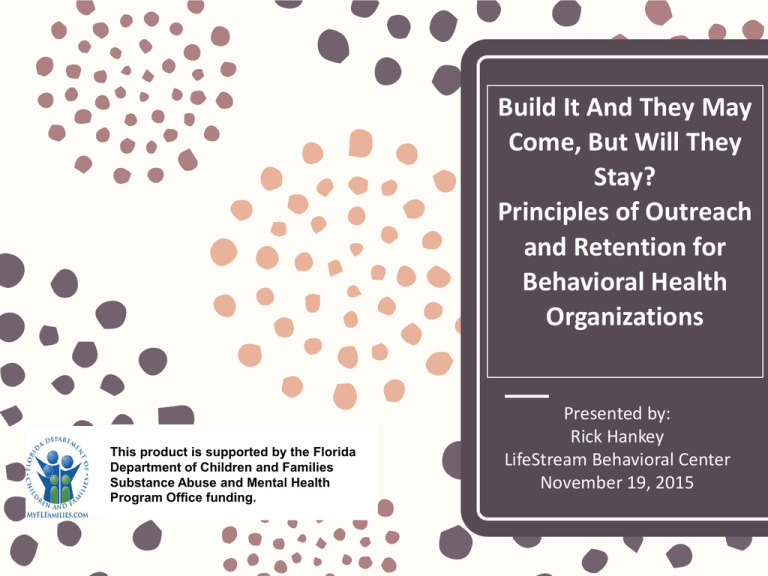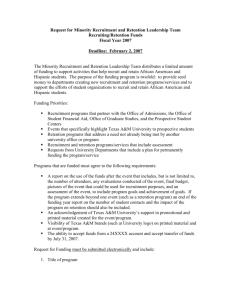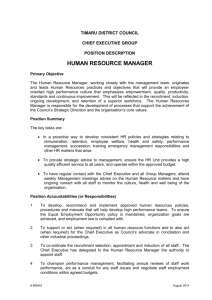View Presentation Materials - Florida Alcohol and Drug Abuse
advertisement

Build It And They May Come, But Will They Stay? Principles of Outreach and Retention for Behavioral Health Organizations This product is supported by the Florida Department of Children and Families Substance Abuse and Mental Health Program Office funding. Presented by: Rick Hankey LifeStream Behavioral Center November 19, 2015 Webinar Objectives – Identify the components of a recruitment and retention strategy; – Identify strategies for recruiting new participants and strategies for retaining participants; and – Learn how to develop a process oriented strategy to make recruitment and retention more effective. Demand for Services – 23 million Americans need treatment – 25% are able to access treatment – 50% of those in treatment do not complete – The way services are delivered is a barrier to both access and retention. SOURCE: NSDUH, SAMHSA, 2006. Demand for Services Drug Overdose Deaths in the U.S. 2012 2011 2010 2009 2008 2007 2006 2005 2004 2003 2002 2001 2000 1999 0 5,000 10,000 15,000 20,000 25,000 30,000 35,000 40,000 45,000 1999 2000 2001 2002 2003 2004 2005 2006 2007 2008 2009 2010 2011 2012 Deaths 16,84917,41519,39423,51825,78527,42429,81334,42536,01036,45037,00438,32941,34041,502 Demand for Services-Drug Overdoses in Florida – 8,587 overdoses in 2014 -- Death rate doubled since 1999 and up 3% from 2013. – 1,821 Opioid involved deaths in 2014 – Equates to five per day and has quadrupled since 1999. – Heroin deaths increased by 124.6% and as a primary cause of death by 111.4% compared to 2013. Demand for Services – 60% of parents in verified child maltreatment cases had evidence of a substance use disorder. – Parental substance abuse accounts for 31% of children in child welfare. – 37% of homeless individuals in Florida experienced a substance use disorder. – Since 1995, the number of neonatal abstinence syndrome in newborns increased by ten-fold in Florida, compared to a three-fold increase across the nation. Demand for Services – The lifetime cost for one individual with fetal alcohol spectrum disorder is estimated to be $2.5 million. – Pregnant women reported an average of 4.6 binge drinking episodes in the past 30 days. This was higher than the average of 3.1 episodes reported by non-pregnant women. – The suicide rate in Florida is higher than the national average. – Suicide is the 9th leading cause of death in the state. Demand for Services – If there is a demand for services, why do we have problems with recruiting and retaining individuals in treatment?? – If there is a demand for services, why do we have no shows?? – If there is a demand for services, why do people stop coming to treatment?? – Is it us? Or is it them? What Do We Mean by Retention and Recruitment – Recruitment is defined as outreach efforts to engage individuals into appropriate levels of care – Retention is defined as keeping clients involved in treatment activities and receiving required services – Both are critical for program and client success Why is This Important? – Drop out is a major problem in substance abuse treatment, especially during the first three months. – Drop out rates of 50-80% are typical. – Attrition results in spending considerable resources on individuals who do not subsequently engage in the treatment process. – Attrition contributes to staff frustration and burnout. – Time in treatment is a predictor of positive outcomes. – Studies have attempted to identify both client and treatment predictors of retention in substance abuse treatment. – Substance use severity, legal status and psychopathology have not been consistent predictors of treatment attrition. Why is it Important? (continued) – Treatment factors affecting retention have been studied and include the therapeutic alliance, ancillary programming offered, counselor characteristics, program barriers, program awareness of dropout as a problem and treatment modality. – Positive therapeutic alliance. – Counselor characteristics versus experience. – Little research focused on relationship between treatment attrition and treatment modality. Factors That May Influence Retention – Sociodemographics – Criminal justice referral and involvement – Same sex versus mix gender groups – Service delivery – Child protective services referral and involvement – Ancillary services – Pregnancy – Counselor characteristics – Supportive Therapy – Confidence in the process – Collaborative Approach – Therapeutic alliance What is a Recruitment and Retention Strategy? – Living, ever-changing document – Ensures recruitment and retention is thoughtful and intentional – Specifies action to be taken with an identified person responsible – Created along with the implementation plan and updated frequently – Informed by the needs assessment and environmental scan Components of a Recruitment and Retention Strategy – Community/population’s need – Recruitment and retention strategy (strategies include recruitment and outreach efforts, selection, assessment process orientation, supervision, training, and support) – Appropriate intervention(s) to support the strategies identified – Recruitment and retention implementation plan to meet the needs of the organization and community (ies) served – Responsible parties and timeline to implement Who Writes the Strategy? – Typically, managers involved with the program management write the strategy – Front line staff implementing the strategy should have a voice in the development of the strategy – Anyone who will be actively recruiting and providing direct services – Individuals served Factors Influencing the Strategy: Potential Barriers – Basic needs-Maslow’s hierarchy – Stakeholder buy-in – Similar or competing programs – Cultural Values – Transportation challenges – Perceptions – Ability to meet individuals needs – Stigma – Family responsibilities – Demands on the agency Factors Influencing the Strategy: Individual Served – What is a voluntary participant? – What is in involuntary participant? – What to do with participants who are present, but not engaged? – Motivation level – Legal status – Co-occurring issues Factors Influencing the Strategy: Agency Specific – Visibility in the community – Referral sources – Agency reputation – Marketing and branding – Human capital – Partnerships – Ability to meet the needs of the individuals served – Understanding of the population served – Rural vs. urban Factors Influencing the Strategy: Staff – Staff recruitment – Cultural awareness – Respect – Reflective of the community – Training – Understanding of the individual’s served Why Process Improvement? – Customers are served by processes – 85% of customer related problems are caused by organizational processes – To better serve customers, organizations must improve processes to meet the needs of their customers – Today’s society wants quick solutions and rapid response Why Organizational Change? – Small changes increase client satisfaction – Satisfied clients are more likely to show up and continue their treatment – More clients in treatment make your work more rewarding – More admissions and fewer drop-outs improve the bottom line – It’s the right thing to do!! Efficiency and Productivity – Reducing no-shows increases direct service hours – Better access can bring in more admissions – Improved continuation yields more billable services – Reduced paperwork liberates more clinical hours Staff Retention – Staff members who view themselves as vital are more likely to stay. – Staff whose contributions are recognized and appreciated are more likely to stay. – Staff who view the organization as successful in carrying out its mission are more likely to stay. Treatment Outcomes – Clients who stay longer in treatment are more likely to have better outcomes. – Clients who have good attendance are more likely to continue and benefit from treatment. – Clients who participate in more treatment sessions are more likely to show measurable progress. Client Satisfaction – Clients are sensitive to good service. – Clients who value the care they receive are more likely to stay in treatment. – Efficient processes are more rewarding and professional. – Satisfied customers stay and encourage others to stay. Why Do Customers Give Repeat Business? Quality of Service Consistency Service Satisfaction LIKE Recruitment and Retention: Is it a Problem for Our Agency? – More than 60% of our consumers leave treatment within the first month… – In our agency, the wait time for an assessment or admission appointment is two and a half weeks… – Our outpatient treatment census has on average 21 individuals a month, but we have room for 50… – Many of the individuals who have an assessment appointment don’t show up, we have a huge no show rate… – Why do people not show up for their treatment sessions? They must not be motivated to change… Maybe Your Organizational Culture is Affecting Recruitment and Retention – Attitude of indifference – Careless environment – Services do not live up to expectations – Unfriendly staff – Lack of warm handoffs – Not meeting the needs of the client – Misinformed staff – They need us more than we need them Insanity is Doing the Same Thing Over and Over again, and Expecting a Different Result. Albert Einstein Key Principles of NIATx Process Improvement Model – Understand and involve the customer – Fix the key problems – Pick a powerful change leader – Get ideas from outside the organization or field – Use rapid cycle testing to establish effective changes Process Improvement – Five Key Questions – What’s it like to be our customer? – What are we trying to accomplish? – How will we know a change is an improvement? – What changes can we test? – How do we sustain the gain? What’s it Like To Be Served By Our Agency? – A walk-through is a key component. – Staff members take roles of a new client and family member. – The goal is to see the process from a client’s perspective. – What is your agency’s experience like and what are the barriers? What Are We Trying to Accomplish? – Change teams. – Change project-process improvement activity that targets one aim, one level of care, one location and one population. – Team members learn to conduct a change project to get more people into treatment and keep them engaged. How Will We Know a Change is an Improvement? – What changes are the most important and how will we know which changes worked and which did not? – Data is collected before, during and after testing the change. – Data is used to measure, evaluate and compare progress towards the goals that have been set. What Changes Can We Test? PDSA Cycle – Plan, Do, Study, Act – Plan the change and how to test if it is an improvement or not…who? What? Where? When? – Do the plan. Document problems and unexpected observations. Begin to analyze the data. – Study the results. – Act on the new knowledge. Adopt, abandon or adapt the change. How Can We Sustain the Gain? – – – – Monitoring effectiveness Adapt the change Keep the change alive Data utilized to track sustainability efforts Examples of Walk-Through Learning – Telephone answering protocol – Information needed to provide assistance at first contact – Wait time and availability of services – Need to address access barriers – First impression of facility – “Welcoming” nature of the 1st encounter – Helpfulness of the intake/assessment process – Smoothness of transition from one level of care to another Principles of Effective Treatment – No single treatment is appropriate for everyone. – Treatment needs to be readily available. – Effective treatment attends to multiple needs of the individual, not just his/her drug use/abuse. – Remaining in treatment for an adequate period of time is critical. – Many drug addicted individuals also have other mental disorders. – Treatment does not have to be voluntary to be effective. – Drug use during treatment must be monitored continuously as lapses during treatment do occur. – Medically assisted detoxification is only the first stage of an addiction. treatment and by itself does little to change long term drug abuse. – An individual’s treatment and services plan must be assessed continually and modified as necessary to ensure that it meets his/her changing needs. Engagement of Priority Populations – While all individuals served have unique needs, there are priority populations identified in the State of Florida. – The priority populations include Pregnant and Post Partum Women, Intravenous Drug Users, Services for Communicable Diseases and Prevention Services. – As a result of receiving Block Grant funding, the federal government has imposed specific requirements. – These requirements can serve as a way to engage individuals into services and meet their needs. – Identification of and immediate attention to the individual’s needs is an effective engagement strategy. – Providers need to ensure that all staff are aware of the requirements. Outreach and Engagement Strategies – Is your agency easily reached by public or private transportation? – Are your services provided in age, gender and culturally appropriate ways? – Does your agency provide multiple services (one stop shop) to minimize transportation time and reduce confusion for the client? – Are the hours of service convenient for the individuals you serve? – Are your staff appropriately trained? – What is your recruitment strategy? – What engagement practices does your agency utilize? – Is your agency a safe place for your consumers? Importance of Retaining Priority Populations –Case Study 1: Negative Impact –Case Study 2: Positive Impact Promising Practices: Timeliness – – – – – – – Ensure access when clients need it. Reduce intake and assessment paperwork. Change schedules and offer assessments daily & in the evening. Encourage same day assessments. Provide walk-in assessment clinic. Is your system user friendly? Are staff trained to answer questions and provide appropriate information? Promising Practices: No-Shows – Engage clients as soon as possible. – Clearly explain what the client can expect at their first appointment. – Model client communication or Motivation Interviewing techniques. – Get clients in for the first appointment quickly. – Make reminder calls for scheduled intake/assessment appointments. – Identification and attention to immediate needs. – Call clients who no-show to re-engage them in treatment. – Ask clients about barriers to coming to their next appointment and help them find solutions, e.g., transportation, child care, work. Promising Practices: Increase Admissions • Offer outpatient orientation, pre-contemplation, and/or skill training groups. • Eliminate required length of stay; individualize and negotiate treatment plan; move to the next level of care when ready. • Build special relationships with referral sources. • Assessments focus on the complex needs of the client. Staff are trained to be non judgmental and able to determine critical immediate needs. • The whole person is addressed, not just treating the addiction. • Offer services during intake. • Stages of Change/Motivational Enhancement Techniques. DRAFT Promising Practices: Continuation – Connect client & counselor within 48 hours – Provide a welcoming orientation – Identify clients at-risk for leaving – Use motivational enhancement strategies – Use positive reinforcement for desired behavior – Patient centered treatment – Comfortable, non-judging environment - Assess client needs frequent - Contingency management – rewards for continuing in treatment - Utilize motivational interviewing and enhancement strategies - Have peers help orient and connect with new clients - Offer welcoming environment - Thank you notes and birthday cards - Positive and caring staff - Use the group to engage and reengage the client Summary – Changes in society influence how treatment is provided – Customer service – Meeting the needs of the individuals served – Recruitment and retention strategy critical to success – How does your agency rate? First impressions important – Relationships with referrals – User friendly system of care? – Talk the talk or walk the walk? – Process Improvement Model – Walkthroughs critical – Data is your friend-what are the trends? – Staff training-knowing how to answer questions and provide accurate information – Recruitment and retention strategies need to be reviewed frequently; it’s an on-going process – Block grant requirements a way to engage priority populations QUESTIONS?? Rick Hankey Chief Hospital Officer/Sr. Vice President LifeStream Behavioral Center Email: Rhankey@lsbc.net




